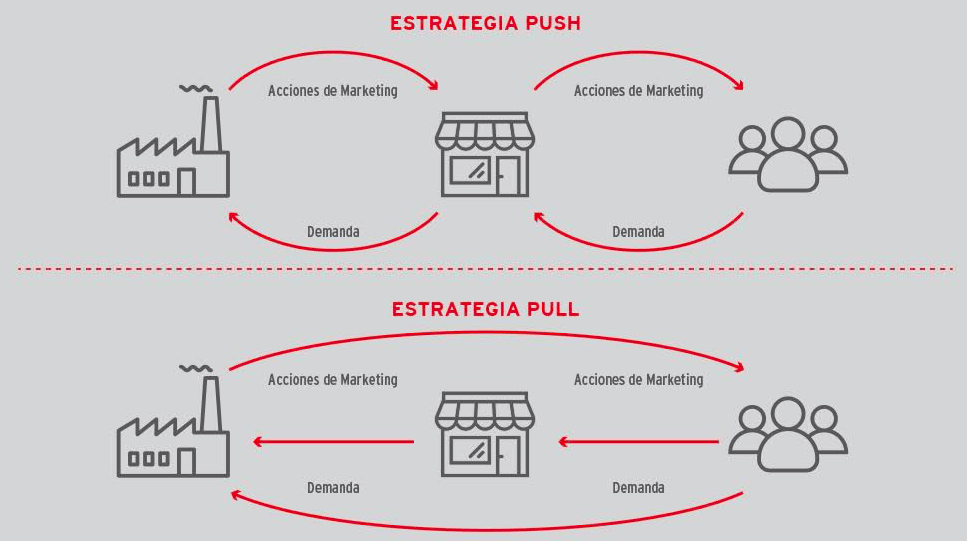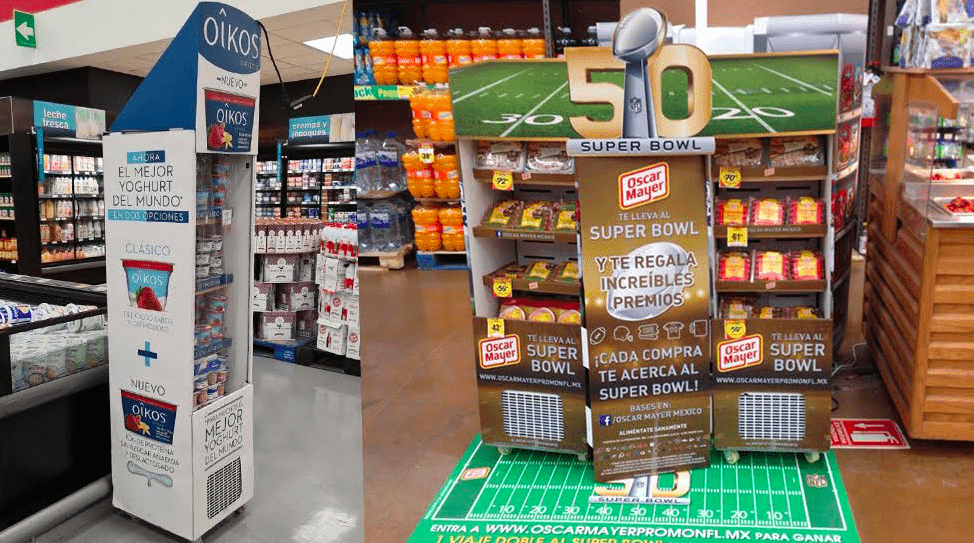Nowadays, sales strategies are very important cornerstones for companies to obtain good financial results and profitable growth. For this reason, more and more, brands investigate the shopper at the point of sale with the purpose of creating strategies to increase their sales and win more loyal consumers.
Through these studies, various methods have emerged to attract the shopper; among these are and Trade Marketing and Shopper Marketing.
In this article, we will thoroughly explain each one and why it is important to use them with your brand at the point of sale.
When does Trade Marketing start?
The Trade Marketing emerged in the 80s and has managed to establish itself in the retail sector, reaching tactics that have made some supermarkets design exclusive departments with this type of strategies in order to increase sales and keep the brand's positioning in the mind of the final consumer.
Currently, many companies allocate a large percentage of their budget to the design and development of this type of strategies.
What are the Functions and Purposes of Trade Marketing?
The Trade Marketing has various functions such as:
On the other hand, we can define Trade Marketing as a set of actions that the manufacturer designs according to the conditions and the specific strategy, taking into account the characteristics of the segment and the points of sale in order to obtain a common purpose: to satisfy the consumer and the distributor.
“Advertising is basically persuasion, and persuasion is not a science, but an art”. -William Bernbach. 1
This is created by implementing a marketing strategy between the manufacturer and the distributor, designing and implementing together a plan that will be profitable and effective for both. The idea is that both can share knowledge and information on market’s behavior. In this way, they will seek to improve their business relationships merchandising techniques, streamline logistics and distribution and increase inventory turnover at the different points of sale.
This rotation can be achieved through promotions for the end consumer. This is how it becomes mandatory to define the different types of Trade Marketing tactics, taking into account the various options at the point of sale.
What steps should I follow to Develop a Trade Marketing Plan?
1.Carry out a Market Research.
the research will help you better understand the consumer, monitor trends and factors related to your particular type of industry.

2. Design a Solid Plan.
Having your market research ready, it is then necessary to design a solid plan to help you establish goals; That is,where do you want to channel your marketing efforts?, How much capital are you willing to invest in commercial strategies? What are your goals as a company?

3. Invest in Branding.
The to buy make purchase decisions based on their emotions much more often than considering the characteristics of a product; This is why the brand is so important and investing in Branding becomes vital.
Attaining customer loyalty and creating a connection between them and the brand goes far beyond your products. The difference lies in the manner in which you carry out your marketing strategies.

What strategies do we suggest you use in Trade Marketing?
1.Push & Pull
Companies, must apply push & pull sales and merchandising strategies to achieve market positioning and a good institutional relationship with the distributor.
What do we mean when we talk about a push & pull strategy?
What we know as pull or attraction strategy is that which is directed right at the consumer, with the purpose of attracting them to the brand. A brand’s pull strategies are those that we observe every day, among which are brand activations. Brand activations are usually very attractive since they are advertised with a not so discreet communication.
In advertising, when applying the marketing pull, the consumer becomes aware of the stimulus he is being exposed to.
Unlike pull marketing, push marketing is directed towards the distribution channels since it is a strategy that works downward, from the manufacturer to the distribution channel and from the channel to the consumer. It is a very good option that is active at the time of making push sales.
What differences can we find between push & pull strategies?
The Pull strategies focus on the consumer, while push focus on distributors.
Pulls are 100% visible because they serve as an advertisement to other potential consumers, while pushes are usually not communicated with much emphasis.

2. Merchandising and Visual Merchandising
The Merchandising refers to various techniques based on the presentation of the product, the rotation and its profitability in a system of actions at the different points of sale; that is, the increase in sales by placing the products in the appropriate and strategic places, with competitive prices in the market and in sufficient quantities.
It is important to emphasize the importance of Advertising Material that has been created and designed to attract the attention of Shoppers.

3.Promotions
The Promotions represent various ways of transforming the relationship between quantity and price, increasing the perceived value of the Shopper with respect to the offer. The promotional items or "hook items" play an important role in this strategy.

What is Shopper Marketing?
“"According to a study carried out by PPAI, promotional items have an important impact on those who receive them, since 94% of consumers remember a gift from the company received in the last few years, and 89% remember the brand."2
Unlike Trade Marketing, and Shopper Marketing is defined as a marketing strategy at the point of sale that takes into account the different types of buyers there are.
Not all customers are the same, since people with different tastes and aversions enter a store.
The secret of Shopper Marketing lies in the in-depth knowledge of the Shopper (buyer /client), as well as the correct use of this information when designing marketing strategies for the point of sale.
The Shopper Marketing is the one that is carried out in the final stretch towards the purchase. It is marketing that leads the Shopper to buy a product from one shelf and not another.

When we talk about Shopper Marketing, it is important to differentiate the Shopper from the end consumer, since a Shopper can be a woman who buys women's shampoo, and at the same time buys men's deodorant for her husband, and formula for her baby. The Shopper buys these products; however, she is not always the end consumer of them.
What are the functions of Shopper Marketing?
1. To improve the Presence of the Brand, with a good Shopper Marketing strategy at the point of sale, las marcas logran alcanzar mayores probabilidades de ser más visibles y reconocidas por el Shopper, lo que ayuda a incrementar sus ventas.
2.To manage that Shoppers buy on impulse, If you have an effective Trade Marketing with also effective exhibition, merchandising & promotions at hand, at the point of sale you will get shoppers to acquire additional products.
"According to a study published by the Point of Purchase Advertising Institute - POPAI(2018)," 82% of purchase decisions are made at the point of sale ".3
3. To help the Shopper receive messages that bring them closer to your brand, improving their shopping experience and connecting with the brand and the retailer.
"The best advertising is done by satisfied customers". - Philip Kotler.3
Conclusions:
The Shopper Marketing studies and knows the different type of Shoppers, their behavior and buying habits, in order to define the elements to be implemented at the point of sale to generate stimuli and emotions elements to be implemented at the point of sale to generate stimuli and emotions that related to the positive shopping experience of the Shopper point of sale.
The Trade Marketing is to carry out strategy, the point-of-sale, satisfying both Shoppers and retailers, according to the characteristics of the segment, the product portfolio, and the distribution channels, making the brand stand out at the points of sale, in order to encourage his purchase.
Both areas are the basis for a contemporary consumer products company. Because now, more than ever, Shoppers know the power they have over brands demanding extraordinary situations for each product or service they buy.
It is necessary for both departments to be in constant communication, since they pursue the same goal: increasing sales for the brand.
One of them analyzes the buyer (Shopper Marketing) and the other (Trade Marketing) negotiates and is carried out store by store. So that together they can create an in-store experience that persuades Shoppers to buy a product or service.
The important thing here is to remember that both are essential for a perfect performance at the point of sale and together they have a symbiotic relationship with the sole purpose of increasing the value of the brand..
Use them with your marca and you will see how your sales at the point of sale.
Más en trade marketing.



